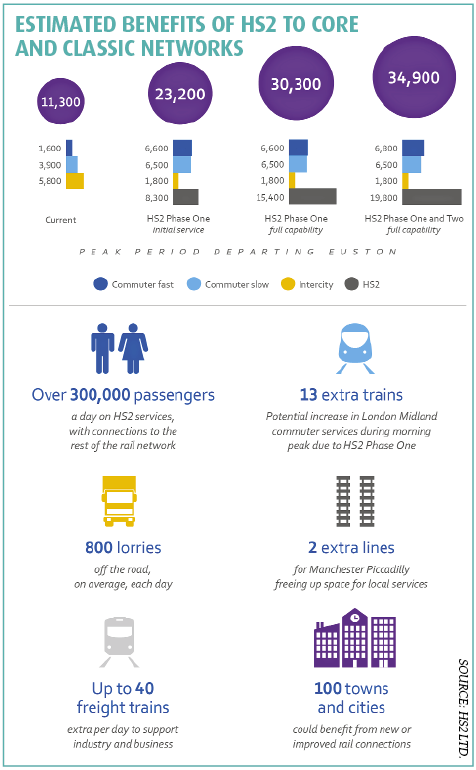“HS2 isn’t just acting as a catalyst for change at a national level but also - and perhaps even more so - at a regional and local level.”
These are the words of HS2 Ltd Chairman Sir David Higgins, in the foreword to the most recent report published by HS2 Ltd on October 31.
Changing Britain: HS2 Taking Root isn’t just another document arguing the case for improved north-south connectivity. Instead, it focuses on the considerable fringe benefits to the towns and cities peripheral to the route, and how HS2 will be a key part of future plans and strategies for localised economic growth.
While much stock has been placed in how the new line will affect London, Birmingham, Manchester and the other cities located on the core network, this report highlights what is being done in nine other areas, which are readying themselves for the arrival of HS2 trains that will run on HS2 metals and then on to the classic network.
A trebling of seats available from Euston during peak hours from 2033, and the consequent freeing up of capacity on the classic network for additional passenger and freight paths makes HS2 an appealing prospect for all areas of the UK, opening up new regional markets and making HS2 a key strategic element of the Northern Powerhouse and Midlands Engine agendas.
In some cases, the benefits of HS2 will be felt at several peripheral locations, even before parts of the core network come online. Both Stafford and Crewe could be welcoming high-speed services accessing the West Coast Main Line beyond the physical limits of phases 1 and 2a of HS2 once they are built in 2027 - a full six years before they will be able to serve Nottingham, Sheffield or Leeds on Phase 2b.
That fact makes it even more critical to consider how HS2 will affect the periphery, in addition to the better-understood impacts on the core.
Says Higgins: “Now we are beginning to see it in those areas which will not be directly on the newly built railway line, but will be served by HS2 trains. These will run on to the classic network to areas such as Newcastle, York and Darlington in the east and Liverpool, Stafford, Warrington, Preston, Wigan and Carlisle in the west.
“As the examples in this report amply illustrate (see overleaf), these areas too are making HS2 an integral part of their plans for the future. As they do so, three themes are strongly emerging.”
From the evidence presented in the report, it states that the first theme is a valuable lesson learned from the construction of HS1 in Kent - that it is key to plan for high-speed services as soon as possible, and to be proactive rather than reactive in forming co-ordinated responses and action plans.
Secondly, the benefits of HS2 are as much a result of improved connectivity between the regions than any gain in journey times to London. Local leaders in the nine areas covered by the report have described how they are beginning to think about new ways of trading with each other to rival the talent and innovation of London, in addition to simply tapping into what the capital can offer.
Finally, the strategic response to HS2 services is being ‘driven from the bottom up, rather than the top down’, and regions are identifying local strengths and how they themselves can take them to a higher level, rather than relying on centralised and remote forms of planning.
“The regional voice of Britain - so strong in the Victorian era when the original railways were born - is making itself heard again,” Higgins concludes.
“The next challenge will be to join up and integrate those local economic strategies into a truly national picture – not just for transport but for the economy as a whole.”
Away from the key focus of the report and back on the core network, Higgins and HS2 Ltd’s team of researchers also provide an update on the HS2 Growth Strategies that are still in development for Phase 2b stations; with Phase 1 stations having already completed this process. It develops the initial proposals set out in February’s Changing Britain report and summaries are provided (right) for planned Phase 2b stations in the East Midlands, Leeds, Manchester and the Northern Gateway Partnership (Staffordshire & Cheshire). Sheffield is not covered, however, and it must wait until route plans have been finalised following the alternative recommendations for stations and the route in South Yorkshire that were set out by Higgins in July.




















Login to comment
Comments
No comments have been made yet.